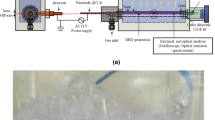Abstract
The polymer flooding tertiary oil recovery technology also produces a large amount of polymer-containing produced water while improving oilfield recovery. The direct discharge of polymer-containing produced water without treatment will cause great damage to the ecological environment. Therefore, the efficient degradation of polymer-containing wastewater has become a research hotspot. In this paper, the degradation of polyacrylamide (PAM) solution by AC/Mn + TiO2 photocatalyst was generated by dielectric barrier discharge (DBD), and the degradation of PAM solution by different PAM solution concentrations, different discharge voltages, and different numbers of AC/Mn + TiO2 particles was studied. At the same time, the morphologies of PAM before and after DBD reaction were obtained by environmental electron microscope scanner (ESEM), and AC/Mn + TiO2 was characterized by ESEM and EDS. The results showed that the soluble degradation rate of DBD to polyacrylamide with a concentration of 1000 mg/L was 74%, while that of 5000 mg/L polyacrylamide was only 53%. The degradation rate of PAM solution was improved by 88%, and the nitrogen oxides generated by DBD reaction can rapidly decrease the pH of PAM solution within 30 min; when the discharge was about 180 min, the PAM molecular chain was obviously broken and gradually mineralized to form water and other inorganic substance thing.













Similar content being viewed by others
Data Availability
The datasets generated during and/or analyzed during the current study are available from the corresponding author on reasonable request.
Code Availability
The examples used in the current study are available from the corresponding author on reasonable request.
References
Chang C, Lin T (2005) Elimination of carbon monoxide in the gas streams by dielectric barrier discharge systems with Mn catalyst. Plasma Chem Plasma Process 25(4). https://doi.org/10.1007/s11090-004-3135-6
Fen L, Ningdong F, Qiang W et al (2018) Correction to “Transfer channel of photoinduced holes on a TiO2 surface as revealed by solid-state nuclear magnetic resonance and electron spin resonance spectroscopy”. J Am Chem Soc 140(39). https://doi.org/10.1021/jacs.8b09506
Kim S, Kwon B, Kim J (2007) Plasma catalytic methane conversion over sol-gel derived Ru/TiO2 catalyst in a dielectric-barrier discharge reactor. Catal Commun 8(12):2204–2207. https://doi.org/10.1016/j.catcom.2007.04.029
Lee HS, Chun KM, Song SJ, Ryu JH, Lee DW, Lee KY, Chun BH (2000) Plasma/catalyst system for reduction of NOx in lean conditions. Proc Combust Inst 28(1). https://doi.org/10.1016/S0082-0784(00)80334-3
Liang WJ, Ma L, Liu H, Li J (2013) Toluene degradation by non-thermal plasma combined with a ferroelectric catalyst. Chemosphere 92(10). https://doi.org/10.1016/j.chemosphere.2013.05.042
Li J, Fang H, Wang W et al (2011) Europium doped titania nanocomposites with enhanced photocatalytic activity towards the degradation of partially hydrolysis polyacrylamide. https://doi.org/10.4028/www.scientific.net/AMR.391-392.219
Liu J, Ji Y, Zhu S, Guo T, Xu L, Dong J, Cheng P (2021) C-dot doping for enhanced catalytic performance of TiO2/5A for toluene degradation in non-thermal plasma-catalyst system. Environ Sci Pollut Res 29(2). https://doi.org/10.1007/s11356-021-15840-z
Markovic MD, Dojcinovic BP, Obradovic BM et al (2015) Degradation and detoxification of the 4-chlorophenol by non-thermal plasma-influence of homogeneous catalysts. Sep Purif Technol. https://doi.org/10.1016/j.seppur.2015.09.030
Nguyen Dinh MT, Giraudon JM, Lamonier JF (2014) Plasma-catalysis of low TCE concentration in air using LaMnO (3+δ) as catalyst. Appl Catal, B. Environ: Int J Devoted Catalytic Sci Appl. https://doi.org/10.1016/j.apcatb.2013.07.008
Pratiwi SH, Susan AI, Yulianto E et al (2019) Degradation of biochemical oxygen demand (BOD) and potential of hydrogen (pH) in POME by DBD plasma. J Phys: Conf Ser 1170(1). https://doi.org/10.1088/1742-6596/1170/1/012025
Qin ZZ, Liu ZL, Zeng YF, Sun JH, Yang KD (2009) The effects of different methods of catalyst preparation on the hydro-electric plasma TiO2-catalyzed degradation of 2,4-dinitrophenol. Environ Chem Lett 7(2). https://doi.org/10.1007/s10311-008-0150-5
Ren YS, Jiang N, Shang KF et al (2019) Evaluation of trans-ferulic acid degradation by dielectric barrier discharge plasma combined with ozone in wastewater with different water quality conditions. Plasma Sci Technol 21(02):68–77. CNKI:SUN:DNZK.0.2019–02–011
Schmid S, Jecklin MC, Zenobi R (2010) Degradation of volatile organic compounds in a non-thermal plasma air purifier. Chemosphere 79(2). https://doi.org/10.1016/j.chemosphere.2010.01.049
Sulek MS, Mueller SA, Paik CH (2008) Impact of Pt and Pt-alloy catalysts on membrane life in PEMFCs. Electrochem Solid-State Lett 5. https://doi.org/10.1149/1.2889000
Syakur A, Zaman B, Nurmaliakasih DY (2017) Statistical Analysis of reducing biochemical oxygen demand (BOD) on industrial rubber wastewater using dielectric barrier discharge plasma. IOP Conf Ser: Mater Sci Eng 190(1). https://doi.org/10.1088/1757-899X/190/1/012026
Tian C, Chuanlong M, Anton N, Savita VKP, Nathalie DG, Rino M (2022) Plasma degradation of trichloroethylene: process optimization and reaction mechanism analysis. J Phys D: Appl Phys 55(12). https://doi.org/10.1088/1361-6463/ac40bb
Zhang Y, Xin Q, Cong Y et al (2013) Application of TiO2 nanotubes with pulsed plasma for phenol degradation. Chem Eng J 215-216.https://doi.org/10.1016/j.cej.2012.11.045
Funding
This work was supported by the Key Laboratory of the Ministry of Education for improving oil and gas recovery (NEPU-EOR-2021–01), National Natural Science Foundation of China “Study on the mechanism of non-equilibrium plasma induced condensation of supersaturated steam” (No. 51706023), and project supported by special fund for postdoctoral in Heilongjiang Province (No. lbh-z20118).
Author information
Authors and Affiliations
Corresponding author
Ethics declarations
Conflict of Interest
The authors declare no competing interests.
Additional information
Publisher's Note
Springer Nature remains neutral with regard to jurisdictional claims in published maps and institutional affiliations.
Rights and permissions
Springer Nature or its licensor holds exclusive rights to this article under a publishing agreement with the author(s) or other rightsholder(s); author self-archiving of the accepted manuscript version of this article is solely governed by the terms of such publishing agreement and applicable law.
About this article
Cite this article
Xiaobing, W., Chenyang, Z., Sen, L. et al. Study on Catalytic Degradation of Oilfield Wastewater Containing Polymer by Non-equilibrium Plasma and AC/Mn + TiO2. Water Air Soil Pollut 233, 366 (2022). https://doi.org/10.1007/s11270-022-05840-1
Received:
Accepted:
Published:
DOI: https://doi.org/10.1007/s11270-022-05840-1




